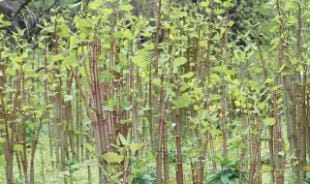A person with knotweed growing on their land is not causing an offence by allowing its presence. However, they could face legal consequences if they ignore the spread of Japanese knotweed next door, by allowing it to spread into the wild. So, what do you do when there is Japanese knotweed in a neighbour’s garden, or elsewhere on their property?
The spread of knotweed is unlikely to result in a case that would constitute physical damage to property by your neighbour. However, the situation could harm your ability to enjoy your garden or home. A loss of amenity that could also have a negative impact on your property value. Recent Japanese knotweed case law has focused on exactly this.
There’s Japanese knotweed next door, what can I do?
With Japanese Knotweed growing on your neighbour’s land, rather than your own, there could be sense of relief. However, you might also feel a sense of frustration that you are reliant on the neighbour to act. Getting them to involve professionals for removal or treatment of the knotweed suddenly becomes a priority. What can you do if your neighbour is unaware of the problems this alien invasive species can cause?
5 steps to take if your neighbour has Japanese knotweed on their property and you’re worried about it spreading:
- Identify the Plant
Make sure you are certain that the plant in question is Japanese knotweed. Japanese knotweed has distinct characteristics, including bamboo-like stems, shield-shaped leaves, and small white or cream flowers in late summer. If you’re unsure, consult online resources (Five easy ways to identify Japanese Knotweed), or consider hiring a professional. - Record your knotweed sighting
Being careful to respect privacy, and without being intrusive, get a photographic record of the Japanese knotweed and mark the date. In the event the plant spreads, this may be useful to show when and where the knotweed originated. - Talk to Your Neighbour
Open communication is important. Approach your neighbour and politely express your concerns about the Japanese knotweed on their property. They may not be aware of the issue. Discussing it amicably could provide the first step in the solution and make subsequent treatment or removal easier. - Offer Information
Provide your neighbour with information about the risks associated with Japanese knotweed. Make them aware of knotweed’s potential to: decrease property value, exploit infrastructure weaknesses, disrupt drainage systems, and contaminate garden soil. Share reputable sources, like the UK Government’s Guidance: How to stop Japanese knotweed from spreading or the RICS Guidance: Japanese Knotweed and Residential Property. - Seek Professional Advice
If your neighbour is uncooperative, or unaware of the issues seriousness, consider seeking advice from a qualified professional. A chartered surveyor, invasive plant specialist, or environmental consultant should be trained to recognise Japanese knotweed. They can assess the situation and provide a formal report. However, in the case of an invasive weed specialist, they can also provide costs for Japanese knotweed treatment and removal options.
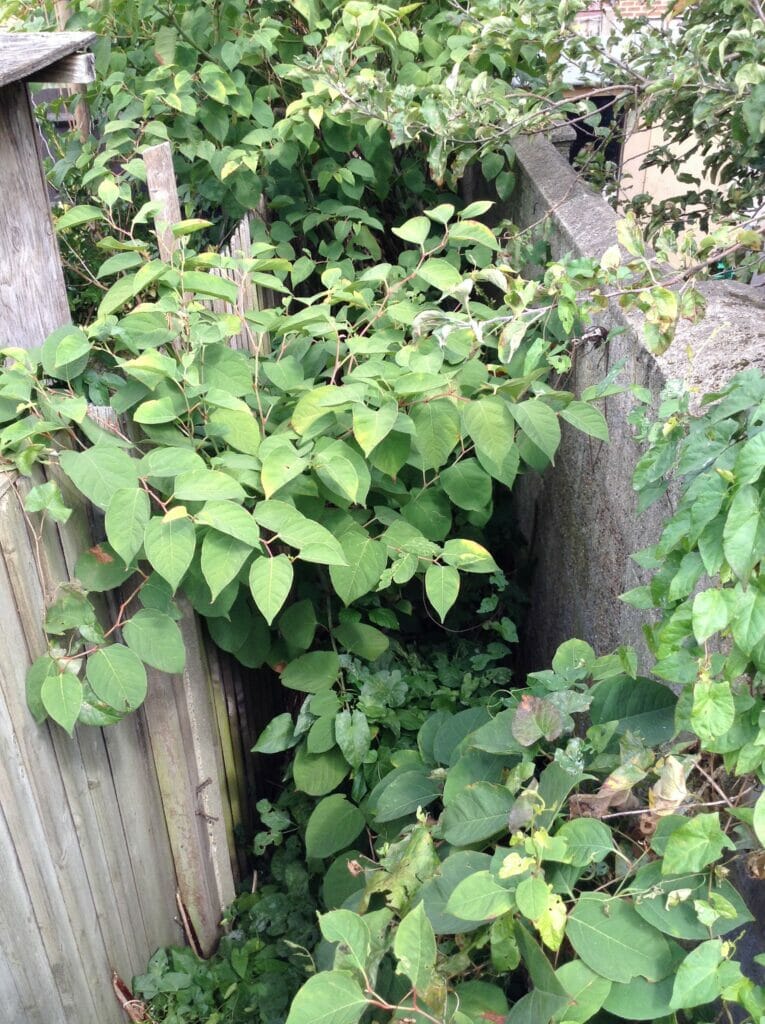
Shared neighbours alley with Japanese knotweed.
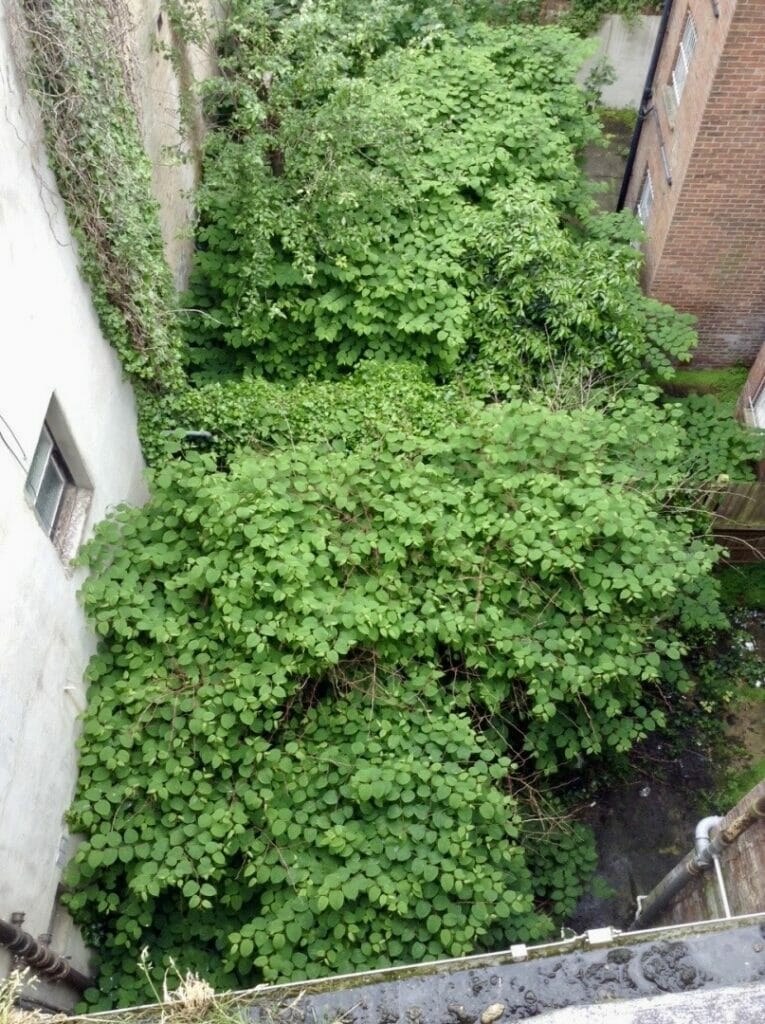
Japanese knotweed impacting multiple properties.
Is Japanese knotweed illegal?
The presence of Japanese knotweed in a neighbouring garden is not illegal. Nor is it, when present on council property, or as in recent cases, on land belonging to Network Rail. Legislation and legal remedies related to Japanese knotweed concern:
- Allowing the plant to spread.
- The disposal of plant material.
The Wildlife and Countryside Act 1981 is concerned with the spread of the plant. Section 14(2) of the Act makes it illegal to plant or otherwise cause to grow in the wild’ any plants listed in Schedule 9 – which includes Japanese knotweed.
The Environmental Protection (Duty of Care) Regulations 1991 legislates the correct disposal of controlled waste. This is what any Japanese knotweed plant material becomes upon being extracted from the ground and removed from site.
Breaches of either of the above Acts can lead to fines in the thousands or, in some cases, imprisonment. However, in instances where the landowner has allowed Japanese knotweed to spread into a neighbouring property, it is seen as a ‘private nuisance’ or ‘public nuisance’ claim. The differentiation between public and private pertains to landownership.
Can I sue my neighbour for Japanese knotweed?
Yes. Success would be based on the court deeming that your neighbour’s Japanese knotweed encroached upon your property, with them failing to act. In such circumstances a remedy would typically be sought as a private nuisance claim.
It is critical is the need to determine if Japanese knotweed rhizomes have spread from one property to another. The rhizome of knotweed is the invasive part of the plant and therefore important to determine where the rhizome has spread. The term often used to describe the spread of knotweed to another property is ‘encroachment’.
Generally, visible knotweed within three metres of a property boundary either has or will encroach upon the neighbouring land. Japanese knotweed specialists asked to determine if knotweed is encroaching upon another property will evaluate this by conducting a site inspection. Satellite photography may also be used to provide evidence the knotweed’s spread.
Any claim based on a loss of amenity – a factor determining a nuisance claim – could result in the claimant winning costs for removal. Alternatively, an injunction could be put in place forcing the neighbour to take steps to treat or remove the Japanese knotweed. In the event a treatment plan is put in place, it may still be deemed that costs are payable for diminished property value. One of the causes of diminished property value results from the stigma often applied to properties with Japanese knotweed present.
Even subject to paying the above costs, the defendant may also find themselves liable to pay the claimant’s legal fees.
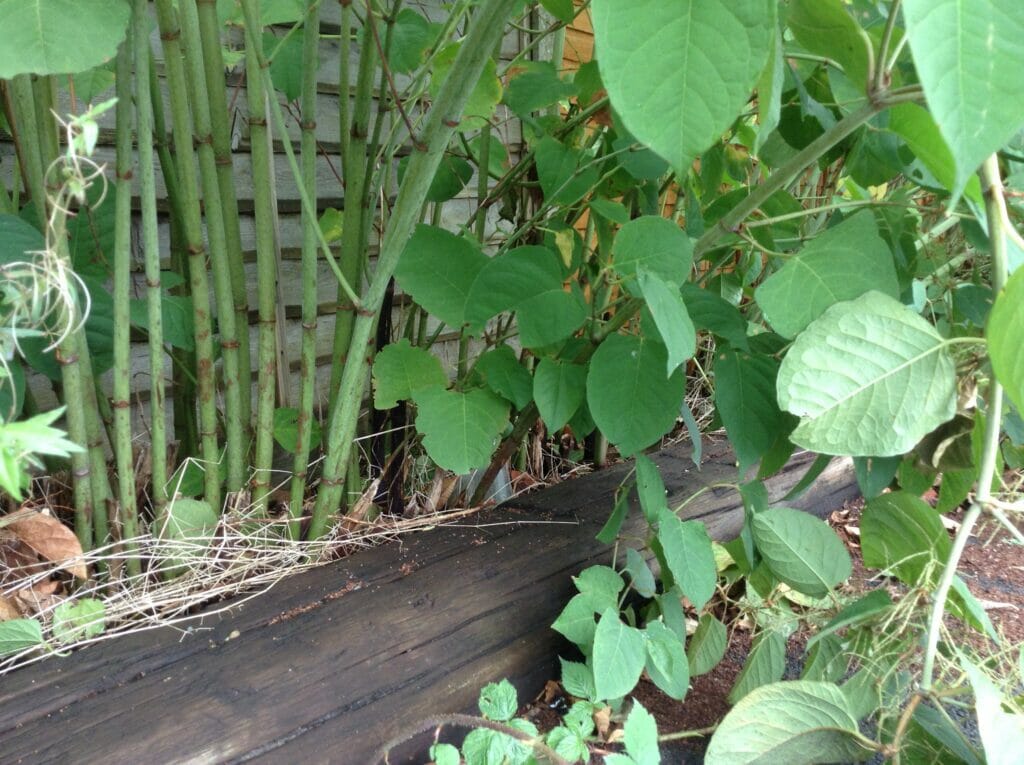
Knotweed growing on a neighbouring boundary.
What to do if a neighbour has Japanese knotweed and ignores it
There are several organisations that can be useful for advice and assistance if Japanese knotweed has spread and communication with your neighbour has failed.
5 organisations to contact if the Japanese knotweed next door has spread to your property:
- Your Local Authority – If your neighbour is uncooperative or does not take steps to control the Japanese knotweed, contact the Environmental Health department at your local council. They may be able to intervene, speak to the neighbour and reinforce the need to not allow knotweed to spread beyond their boundaries. A local authority can use an Anti-Social Behaviour Order (ASBO) to deal with people who fail to deal with knotweed.
- Property Care Association – visit their website for a list of PCA accredited organisations in your area. Organisations of this type will have specially trained Japanese knotweed surveyors and technicians. PBA Solutions is PCA accredited invasive weed specialist who can inspect and advise on knotweed encroachment.
- Call your Insurance Co. – check your policy to see if you have home legal protection insurance. If you do you may be able to use this to pursue a claim against your neighbour for uninsured losses. Failing this, you still may find that your policy covers you for legal advice.
- Involve a solicitor – get a solicitor to write a letter and an invasive weed specialist to advise on the cost to implement a treatment/removal program. Send both documents to the neighbour. If this does not evoke a response, the next course would be to redress the matter in court. You would be making a private nuisance claim against your neighbour, and the cost of taking such action must be considered.
A specialist chartered surveyor – a surveyor specialised in property diminution can be used to provide a RICS Survey that reports the value of your property with and without knotweed present. Any information relating to the diminution of your property can be used by the solicitor in relation to the claim.
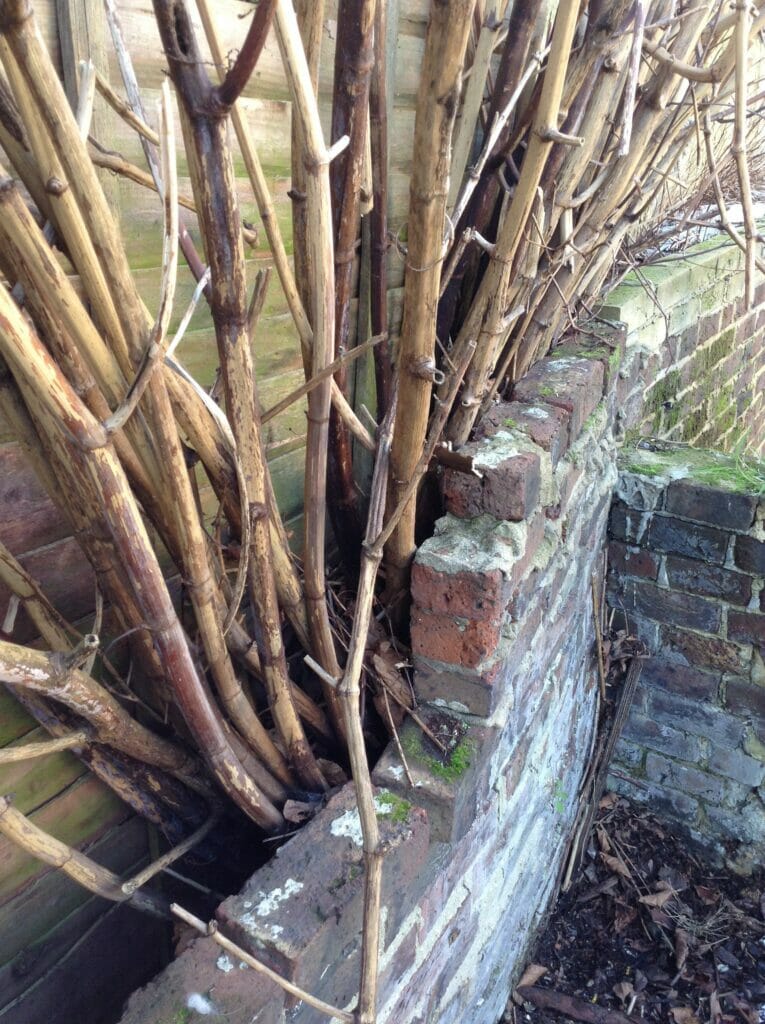
Knotweed from next door damaging wall.
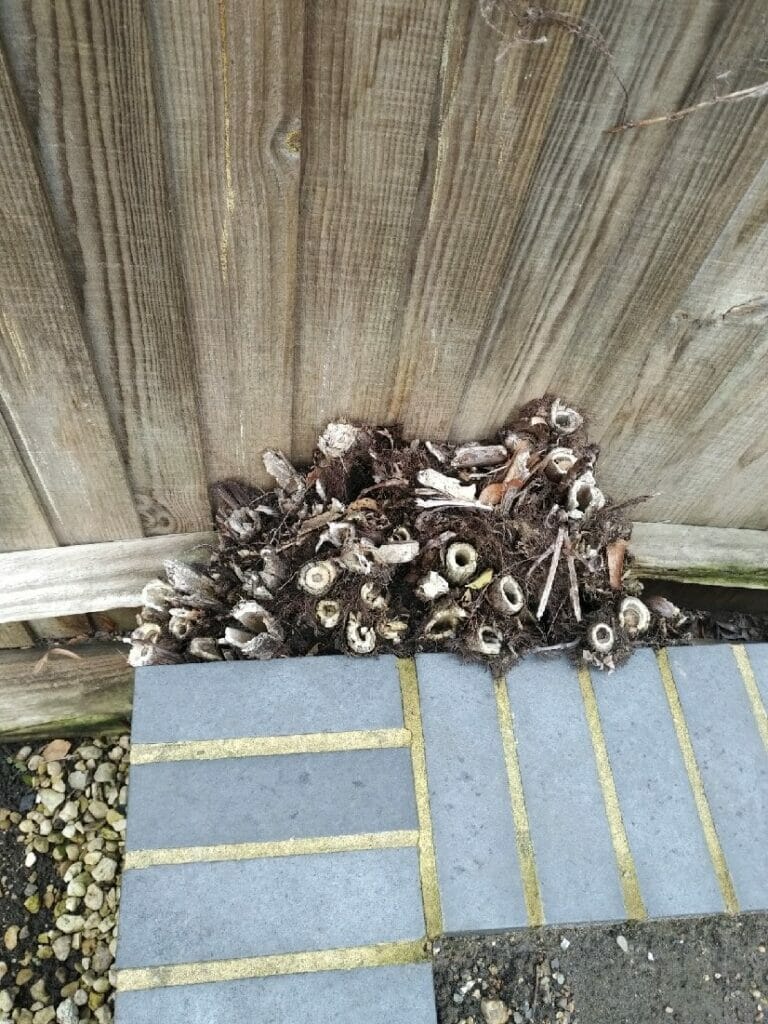
Knotweed crown putting pressure on a neighbour’s fence.
Neighbourly considerations
Remember that dealing with Japanese knotweed can be a lengthy and sometimes costly process. It’s best to approach the situation with patience and a willingness to cooperate with your neighbour to find a solution that serves both properties. Failing that, simply using a solicitor to write a letter can often resolve the problem of the Japanese knotweed next door.
The presence of knotweed on neighbouring land can harm your ability to sell, and, in some (now rarer) instances, to obtain a mortgage. The RICS Guidance Note (GN2022) for surveyors takes a softer approach to neighbouring knotweed than the previous RICS information paper. Now, the potential concern of encroachment is raised where knotweed is visible on neighbouring land within 3m of the property boundary However, crucially no mortgage retention is advised unless circumstances are exceptional.
If you are concerned about the Japanese knotweed in your neighbour’s garden, call 0203 174 2187 or 01202 816134 to talk to one of our consultants. We’ll help put in place a solution to Japanese knotweed next door by encouraging collaboration.


